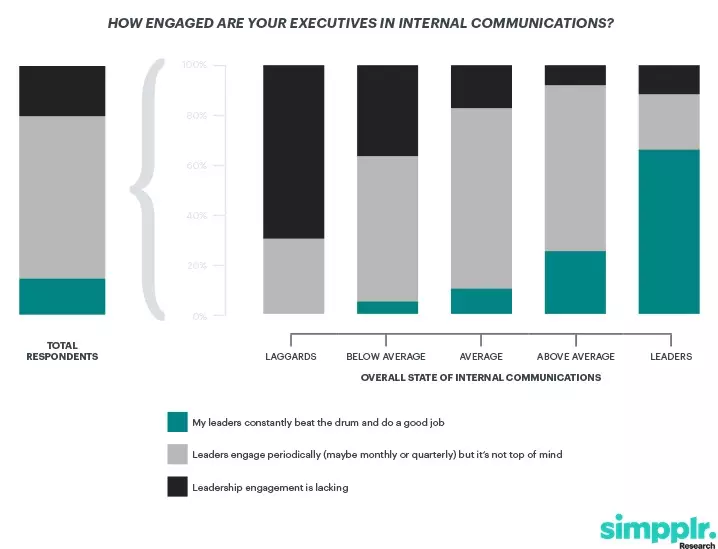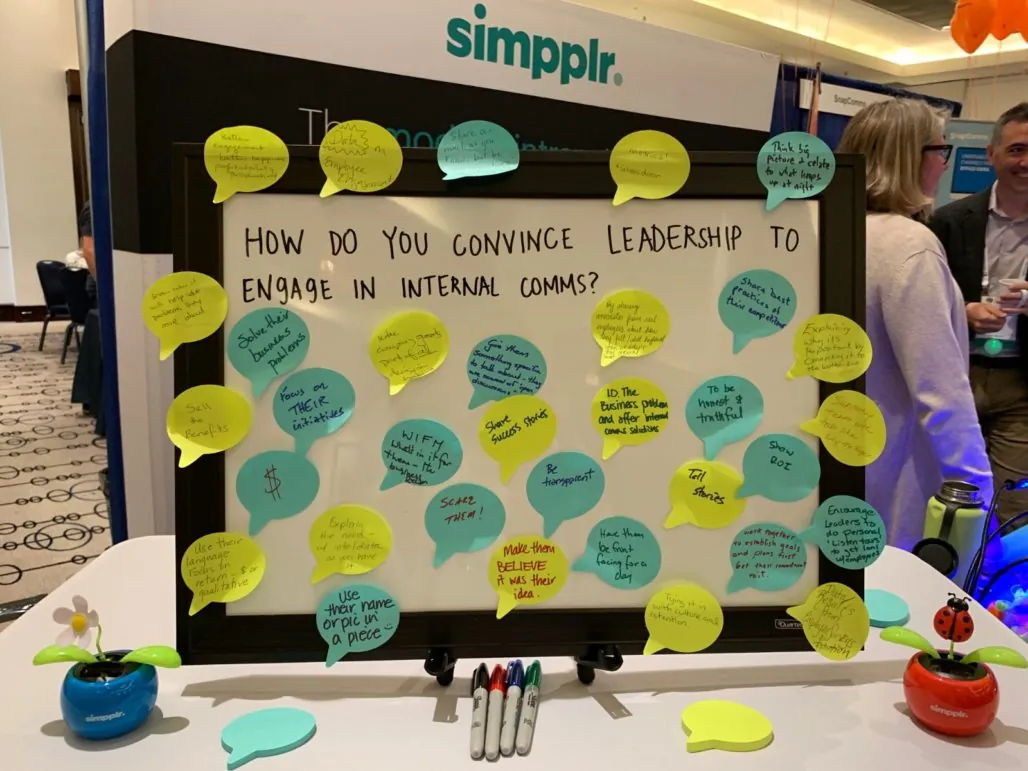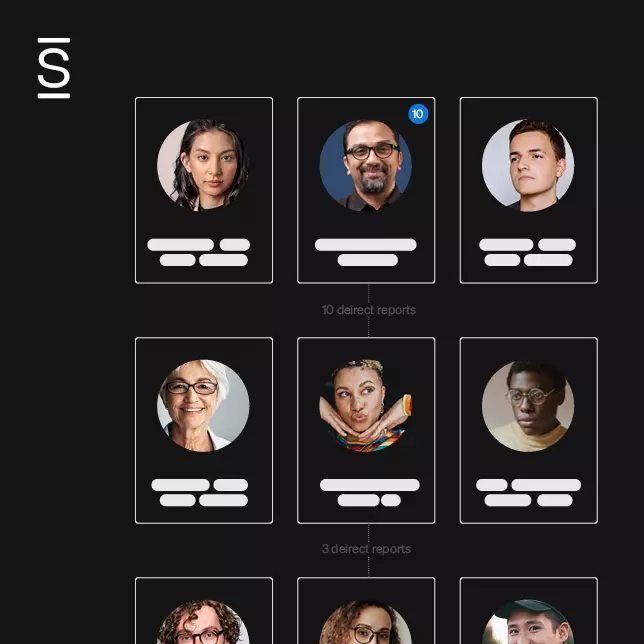Executive communication is critical to internal communications (and intranet program) success. We talk about this a lot, but the theme keeps coming up. Oftentimes, you get buy-in from leadership and it stops there. So how do you actually engage leaders to participate in internal communications?
In Simpplr Research’s newState of Internal Communications report, we see that a big difference between leading and lagging corporate communications programs lies in executive communication and engagement.

Data Analysis: Data for this chart was collected via random sample survey of 411 corporate communications leaders. The survey asks respondents to rate their state of internal communications on a scale of 1-5, with 5 indicating a great internal communications program and 1 indicating a severely lacking internal communications program. Further, the survey asked respondents how involved executives were in their internal communications program. The comparison of responses to the two questions is depicted in the above charts. The breakdown shows that organizations, where the executives are extensively involved in internal communications, have higher ratings on average. This trend is strictly monotonic, with increased executive involvement associated with increased internal communications strength at every level. The upper breakdown further shows this trend; leaders in internal communications have higher executive involvement. The large sample size gives us the statistical power to test this difference. The difference in the average state of internal communication between organizations with extensively involved executives and uninvolved executives is significant at the 0.05 alpha level.
To learn more, you can download the 2019 State of Internal Communications here.
Based on our study, we understand that it’s a challenge to truly engage executives in internal communications (IC). We also know that leadership engagement is critical for the success of internal communications programs. Because of this, we’re always on the lookout for best practices on how to engage leaders. So we’re actively working with customers and the broader IC community to gather deeper insights, tips, and practices.
10 Best practices to engage executives in internal communications
We invited a Simpplr customer from an organization with over 2,000 distributed employees to co-host a webinar and share how they engage leadership to connect their organization.
She discusses a notable section of the webinar around how they work with executives to drive leadership engagement. Here are some internal communication best practices and highlights from the webinar:
Align the intranet initiative with an existing strategy
This shows how corporate communications are a natural extension of existing priorities rather than convincing leaders to worry about one more thing.
Always tie your intranet strategy to a broader vision
Watch the webinar clip to learn about their vision and how they rolled the intranet initiative up to the vision and ultimately the existing strategy.
Leaders need to lead by example
In order to shift the culture from a one-way communications organization to creating a culture of two-way communications, leaders need to be the first to dive into the waters. This essentially gives “permission” to the rest of the organization to follow.
The presenter also made an interesting point for all those organizations who are trying to switch from a top-down communications model to two-way, collaborative communications culture. She believes “this can only work with leadership involvement. It’s intuitive when you think about it, but not something many organizations realize.”
If you’re looking for effective ideas to drive executive communication engagement, here is the full webinar presentation. The section on executive communication training starts at the 17:40 mark and goes for approximately 10 minutes.
Provide executives intranet training and toolkits
Make it as easy as possible for leaders to use the intranet. Leadership engagement is more likely if you provide detailed examples of how they should engage. Training collateral included “10 easy ways to get started” and “What to do vs. what not to do”
Create organization-wide training
You should start the training at the executive level, but don’t stop there. All employees need to be encouraged and guided to use the intranet for maximum engagement. Employee training should include the best practices to use the intranet and differentiate the type of content that should be on the intranet vs. email.
Continue to beat the drum on the intranet initiative
It goes farther than planning. You need to lead and keep the initiative top of mind, including creating a project plan, training lessons, demoing the technology, and more.
Create an editorial calendar for your leadership team
This shows how most of the work is already done. Promote leadership engagement by guiding executives to write about certain topics.
Leverage the intranet initiative as a channel for new management
Because the company was undergoing new management changes, they strategically aligned the change in management with the intranet promotion strategy. The CEO was a vocal part of their intranet launch.
Involve leaders early on, before launch
Show off your intranet tool to your executives well ahead of launch. This helps position the intranet more of a collaborative initiative with your leaders participating in part of the program. Preparing them ahead of time will get them more invested in the intranet and allows for feedback intake.
Use intranet data and analytics to keep intranet engaging
Don’t just create content for the sake of creating it. Be strategic and spend more time on the types of content that resonate with your employees. A modern intranet should have analytics that will guide you in your content strategy to maximize employee engagement.
Crowd-sourced tips to drive leaders to engage in internal communications
At this year’s IABC conference, we had a sudden idea and rushed to Staples right before the event. We bought a whiteboard and some post-it notes and asked conference attendees to answer: “How do you convince leadership to engage in internal comms?”

We were impressed with the internal communications community’s interest! (And will shamelessly call out anyone in our space that copies our idea!) It spurred many meaningful conversations, but we were struck by how many internal communications professionals stood in front of this board for several minutes giving the question a lot of thought. It’s a challenge – and it wasn’t easy to answer. We found that many of the responses echo similar themes.
We decided to take each of the post-its and transcribe them for your enjoyment. The responses were of great advice (and funny!).
Here is the list of crowd-sourced tips to drive leadership engagement toward internal communications
- Support teams with tools like key messages
- Be honest and truthful
- $
- Focus on THEIR initiatives
- Solve their business problems
- Tell stories
- Survey employees and show the need
- Show ROI
- Tie it to culture and retention
- Encourage leaders to do personal “Listening tours to get 1-on-1 with employees”
- Use their name or picture in a piece 🙂
- Sell the benefits
- Make them BELIEVE it was their idea
- Have them be front-facing for a day
- Make it easy for them – Short interview, then write (do their work) for them
- Make company goals part of all decision making
- The staff has to know “What’s in it for me”
- Give them something specific to talk about – they are scared of “open discussions”
- WIFM – What’s in it for them (It’s a business reason)
- Explain the need – with info/data as you have it
- Scare them
- Be transparent
- Data on Employee Engagement
- Better engagement – better happiness – profitability, productivity
- Explaining why it’s important by connecting it to the bottom line
- Tell them they don’t have a choice
- Share success stories
- Just go for it
- Think picture and relate to keeps up at night
- Share as much as you know, but be your executives’ closest confidant
- Provide executive communication training
- Do it for them
- Metrics “Glassdoor”
- Explain “How it affects me”
- Show how it will help solve problems they care about
- ID the business problem and offer internal comms solutions
- By sharing anecdotes from real employees about how they felt/what happened when we didn’t have internal comms.
- Work together to establish goals and plans first get their commitment to it
- Share best practices of their competitors
- Funnel employee sentiment upwards
- Use their language. Focus on return – $ or qualitative
- Executive communication skills training
Top takeaways toward leadership engagement
Your internal communications program (and your intranets) need executive communication and engagement. To get started, these are the most important points:
- Map communications to their priorities! Don’t try to create new initiatives. Instead, show how employee communications can help the organization promote, focus on, and deliver toward existing priorities.
- Make it easy. Give leadership a road map of what they need to do to become better communicators and show how you’ll do all of the heavy lifting.
To get a better understanding of how executive engagement quantifiably impacts the success of internal communications programs, we encourage you to download the 2019 State of Internal Communications report. And if you have additional tips to share, please let us know what’s working for you!

















